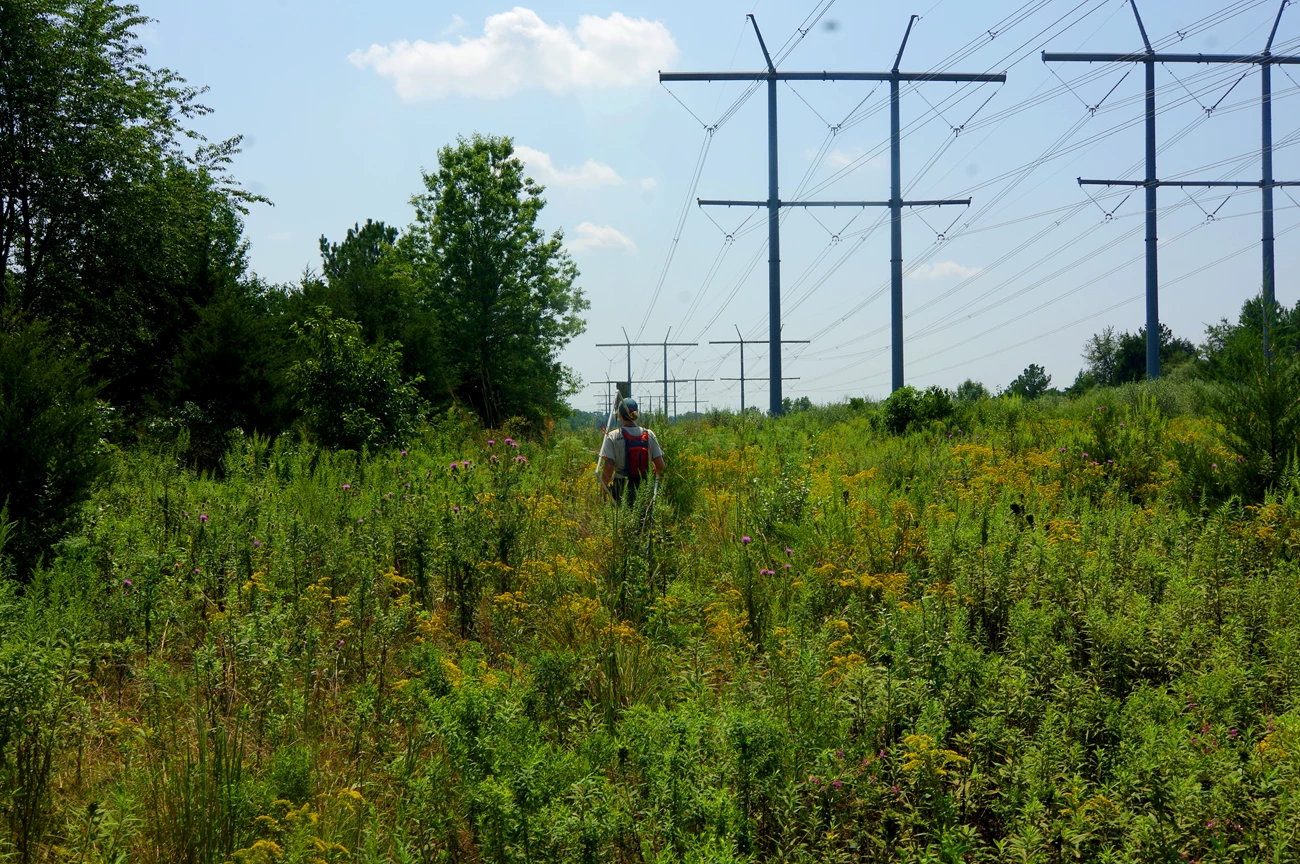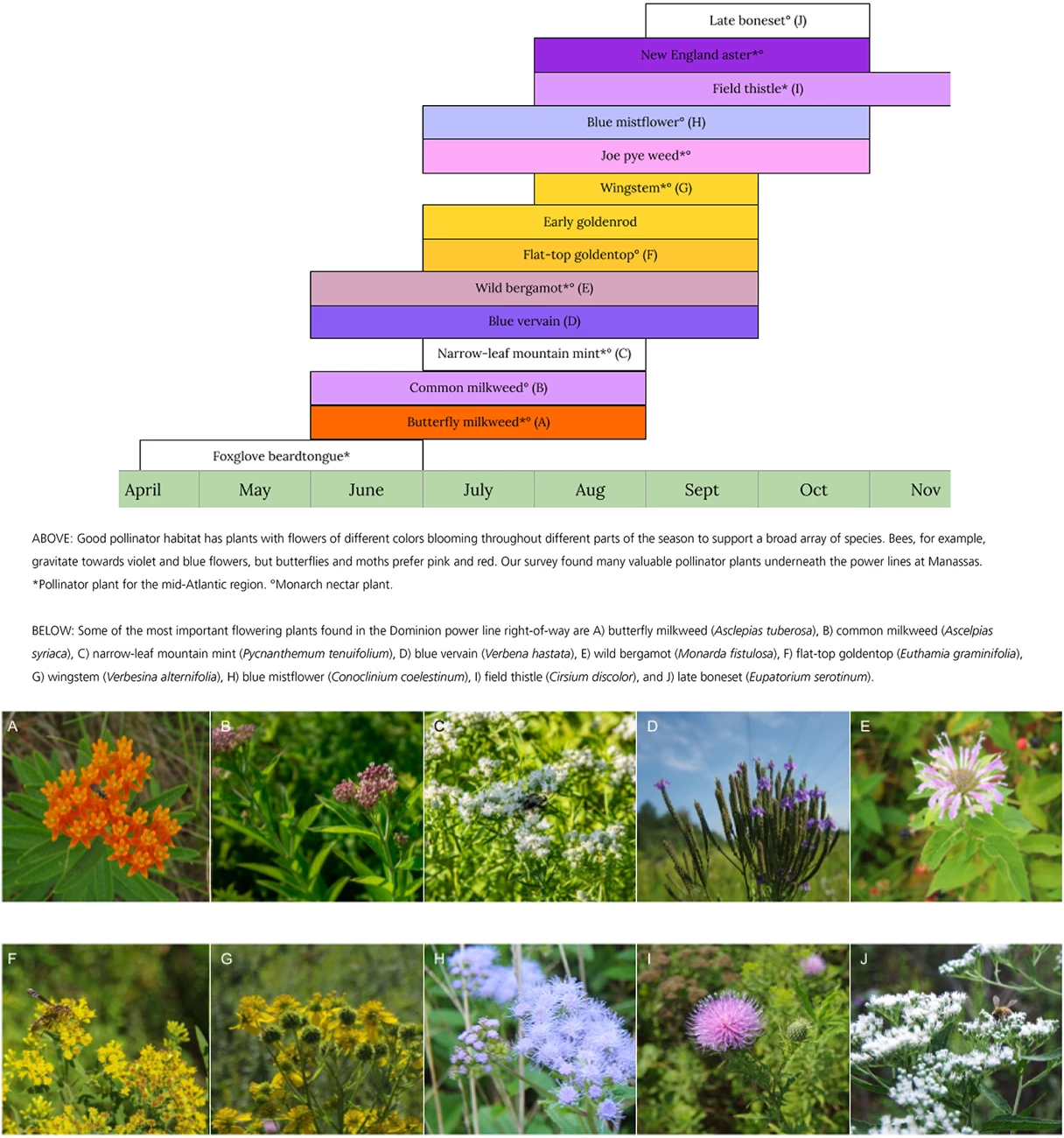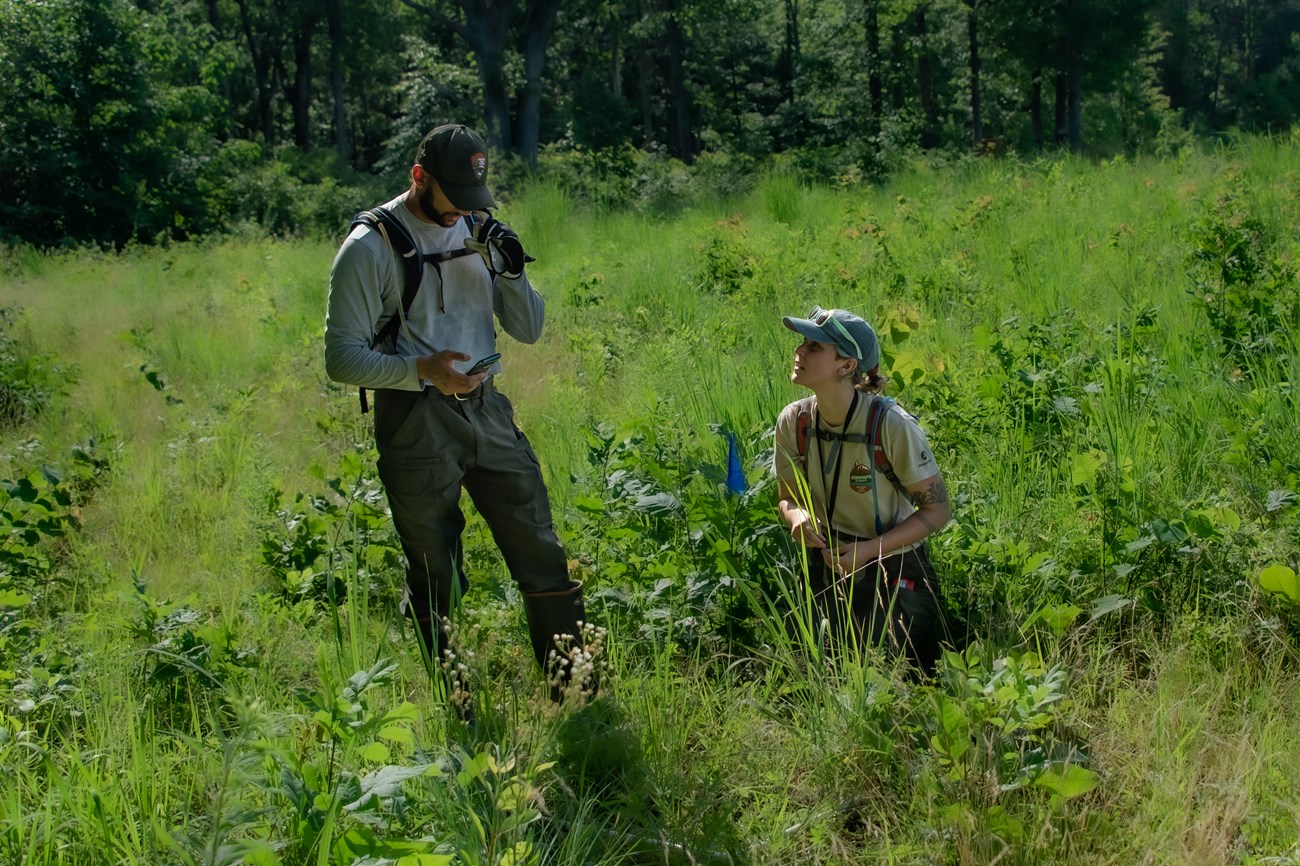Last updated: June 20, 2025
Article
Managing a Right-of-Way Helped This Park Restore Its Grasslands
An unexpected and often forgotten place becomes a vital part of one park’s bid to restore a critically imperiled landscape
By Kelly Ewing

Image credit: NPS / Allison Hay
Manassas National Battlefield Park in northern Virginia is home to a large power line covering 60 acres along the park’s western border. Dominion Energy constructed the line in 2009, clearing the land underneath of all vegetation.
To mitigate the damage, park staff asked Dominion to replant the right-of-way with a native seed mix and manage it as a grassland. Now, 12 years later, we documented 122 unique grassland plants in the right-of-way, including some that are imperiled. Could this strategy be a way to protect our national park grasslands?
Disturbing Trends
Walk through a natural grassland in the State of Virginia in midsummer, and you might find it hard not to linger. You could watch a monarch butterfly flutter by or smell the fresh scent of mountain mint. Close your eyes and you’ll hear the buzz of hard-working bees and bird songs in all varieties of tones and rhythms. You’ll see vibrant colors and tall grasses, which could reach more than eight feet by the end of summer. It is a dazzling display of nature’s bounty.
Natural grasslands owe their existence to disturbance. After land is cleared, burned, or mowed, grasses and forbs (flowering plants that aren’t grasses) are among the first to reappear. Without regular disturbance, a grassland would gradually transition to shrubs and trees until it became a forest a few decades later. Grasslands are ephemeral by nature, an early stage in the natural process called succession.
Prior to European colonization, many believe the eastern U.S. was covered in vast tracts of forest so dense that a squirrel could make its way from the Atlantic Ocean to the Mississippi River without once touching the ground. But the eastern landscape has long been a rich mosaic of forest, wetlands, woodlands, and grasslands. Henslow’s sparrow is a grassland-specific bird that has evolved independently in the eastern United States and can be found nowhere else on Earth. The existence of such animals is one indication of the persistence of eastern grassland ecosystems across generations.
Some estimates are that over 62 percent of grasslands in North America have been lost.
Disturbances that created grasslands before human arrival were largely driven by fire and flooding. Observations dating back to the 1600s show that Native Americans also created disturbance patterns. They used fire to aid with agriculture and hunting, creating mosaics of successional stages in the process. Even with the onset of intensive agriculture upon European settlement, new crop fields served as habitat for grassland wildlife. Though disturbance patterns changed significantly across these eras, grassland ecosystems persisted throughout, a tribute to nature’s adaptability.
Natural grasslands serve many purposes. Ranchers use them for grazing livestock. Grassland wildflowers provide food for native bees and other pollinators. Native grasses supply food, shelter, and nests for wildlife. Visitors across hundreds of federally owned lands enjoy visiting natural grasslands. But Bert Harris, director of the Clifton Institute in Northern Virginia, says that natural grasslands today are threatened by “development, fire suppression, reforestation, planting non-native pasture grasses, and urban development.” Some estimates are that over 62 percent of grasslands in North America have been lost. This is a grim statistic, yet one answer to saving our grasslands could come from an unexpected place.
An Unlikely Solution
Underneath a power line is a section of land called a right-of-way. Power companies have legal access to rights-of-way on public land to perform necessary monitoring and maintenance. This often involves clearing tall or woody plants that could threaten to interfere with the lines. Because of this, power line rights-of-way are uniquely suited for grassland protection and restoration. Eliminating tall woody species serves to maintain the early successional grassland habitat that many species need to survive.
Twelve years had passed since the Dominion power line was installed, and the Manassas resource management team wanted to know how the grassland underneath was faring. We wanted to find out what exactly was growing there, whether it was a healthy grassland ecosystem, and if any management changes were necessary.
To answer these questions, we established 40 randomly dispersed study plots throughout the Dominion power line right-of-way. We analyzed each plot within a one-meter-square area for species presence and abundance using the Braun-Blanquet methodology. We made three rounds of surveys in June, August, and October of 2021. We documented 122 unique species in our surveys and made several important findings.
Grasslands support thousands of pollinator-friendly plants that can’t be found in other ecosystems.
Pollinator Plants under the Power Lines
Approximately 90 percent of wild flowering plants and 75 percent of food crops depend on pollinators. Unfortunately, these species are under threat globally. Forty percent of invertebrate pollinators and close to 17 percent of vertebrate pollinators are threatened with extinction. Grasslands support thousands of pollinator-friendly plants that can’t be found in other ecosystems; their protection is critical for pollinator populations to recover.
The peak months for flowering plants are July through September. In these months, we found many different types of important pollinator plants under the power lines. We found milkweeds, which are the sole larval hosts for monarch butterflies but also attract a wide array of bees and moths. We also found narrow-leaf mountain mint, which attracts native bees and blue and copper butterflies. Goldenrods of several varieties bloomed in the right-of-way at different points throughout the summer, providing nectar for butterflies, moths, and several species of native bees, as well as seed for songbirds.
Early and late summer did not see as many pollinator-friendly plants in the Dominion right-of-way. Plants that bloom in the early and late season are relatively rare and often overlooked, but they provide crucial ecological services. Early bloomers support early emerging queen bumblebees, solitary bees, pollinator flies, and beetles. Later blooming species are vital nectar sources for fall-migrating monarchs. Seeding these plants under the power line would support a wider variety of pollinators across all lifecycle stages.

Image credit: NPS / Kelly Ewing
Good Habitat for Wildlife
Many croplands and unmanaged fields today are dominated by non-native cool season grasses such as fescue. These grasses do little for wildlife, as their dense growing patterns make it difficult for birds and mammals to travel through them. They also discourage other flowering plants from growing. Native warm season grasses, on the other hand, grow in bunches that allow for easier animal movement, support nest building, and provide important animal cover even in winter.
In our survey, warm season grasses such as big bluestem, indiangrass and eastern gamagrass dominated throughout the power lines. Unfortunately, invasive plants such as small carpetgrass and stiltgrass were also quite pervasive. These invasives grow densely, choking out other species and making wildlife movement difficult. They accounted for approximately 27 percent of ground cover in the right-of-way vegetation plots. Eradicating these invasives in areas with significant flowering plants and creating animal pathways could increase the wildlife value of this habitat.
One of the most valuable flowering plants we found in the Dominion right-of-way is showy tick trefoil. This legume fixes nitrogen in the soil, acts as a larval host for three species of butterflies, and attracts six species of long-tongued bees. It’s also an important food source for the Northern bobwhite, a bird of high conservation concern that has several nesting areas in the park. Showy trick trefoil is critically imperiled in Virginia, meaning there is a high risk it could be wiped out in the state. Protecting this species and other rare plants in the right-of-way could help avoid this.
Change of Plan
Based on our findings, the natural resource management team at Manassas is considering changes to how we manage the grasslands in the Dominion power line right-of-way:
-
Our survey showed that herbicide treatments of tall species done by the power company damaged other non-target plants. A study by Harris found that rights-of-way managed by mowing yielded the highest species richness and diversity. Switching from herbicides to mowing every 1–3 years would reduce collateral impacts. We could avoid disturbing ground-nesting birds (such as the bobwhite) during their breeding season by mowing after mid-August.
-
Because invasive plants are prolific throughout the right-of-way, eradicating them in areas with valuable forbs would help us maintain higher native plant diversity. We could use selective herbicide treatments to treat small carpetgrass and Japanese stiltgrass (Microstegium vimineum). This would also create wildlife pathways.
-
We found several rare and valuable plant species in the Dominion right-of-way, such as showy tick trefoil (Desmodium canadense), butterfly milkweed (Asclepias tuberosa), and crested sedge (Carex cristatella). Monitoring and propagating these plants could ensure their survival in the park for years to come.
Broader Implications
Other battlefield parks in the east may also benefit from grassland restoration. It is an opportunity to marry cultural and natural resource management, creating diverse ecosystems that still preserve the historic battlefields that inspired those parks in the first place. Bringing back grassland ecosystems could help visitors engage with the plants and wildlife that were present during the time of the battles and improve the aesthetic value of the battlefields.
Restoring native grasslands could benefit areas outside of national parks. For example, many features of natural grassland ecosystems are beneficial to agricultural crops. Grassland legumes naturally fix nitrogen in the soil. This reduces the need for synthetic fertilizers. Other native grassland plants encourage predatory insects, which help to minimize pest infestations. Native grasses are naturally more drought tolerant than their non-native alternatives. Having more diverse grasses and forbs in pastures may increase their nutritional value for grazing livestock. All these factors could help farmers maintain high yields while restoring crucial habitat.
Of the 38 sites that the Clifton Institute team monitored in northern Virginia, those within rights-of-way yielded the highest species richness and diversity.
Our work shows how forgotten areas can play a powerful role in restoration. Harris calls certain rights-of-way and roadsides “remnant sites.” Because the original seed banks of these sites are likely still intact, they may serve as crucial remnants of what grasslands looked like hundreds of years ago. Of the 38 sites that the Clifton Institute team monitored in northern Virginia, those within rights-of-way yielded the highest species richness and diversity. One site is the third most biodiverse vegetation plot sampled in the state. Some of the plant species the team documented are rare and endemic to the eastern U.S.

Image credit: NPS / Bryan Gorsira
Harris and his team also propagate rare native plants, often not available from commercial seed companies, while educating local landowners about grassland restoration techniques. “We’re able to come up with seed mixes that do a much better job of reflecting what native grasslands would have looked like,” Harris says. “So if people are interested not just in pretty flowers, but they actually want to do restoration, if they have some interest in what these habitats would have looked like, now they know what they can plant.”
Grasslands don’t have to exist as fragmented patches of land. Through collaboration with other land managers and owners, we could restore natural grasslands as an enduring element of the eastern landscape. Our work in the power line right-of-way at Manassas shows that solutions to environmental dilemmas can come from unexpected places.

About the author
Kelly Ewing is an AmeriCorps intern with the natural resource management team at Manassas National Battlefield Park. In addition to her power line project, she surveys wildlife, monitors park grasslands, and helps restore habitat. She hopes to pursue a career in environmental policy. Outside of work hours, she enjoys painting, playing guitar, gardening, and snuggling with her cat, Charles. Image credit: NPS / Mandeep Singh.
